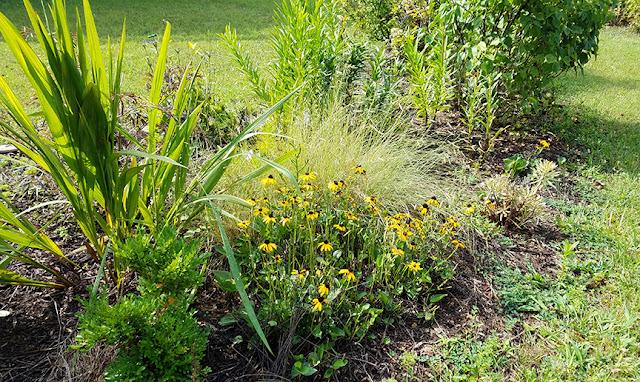 |
| Back yard during a thunderstorm. |
After the prolonged drought of the past few months, August seems to be turning the tide with three powerful thunderstorms within one week, each dropping over an inch of rain. It's almost like the summer monsoons in the Southwest at this time of the year. Out there, the heat builds up during the day to give rise to huge thunderheads that drop incredible amounts of rain on the parched land.
The winds were so strong at the height of one of these storms, that our new cast aluminum bench (a corner of which shows on the lower right hand corner) got blown clear across from one side the deck to the other! The bench was originally by the railing all the way over to the left. Many of my houseplants summering on the deck were thrown off my new plant stands, some were even knocked clean out of their pots! Fortunately, the damage isn't permanent, they'll recover in a day or two.
 |
| Salvia 'Black and Blue' |
Everything in my garden was looking pretty sad before the rains, but now everything is starting to revive. The Salvia guaranitica 'Black and Blue' just started to bloom. My Australian red lime has set some fruit, two nice-sized ones from the past winter and a few more this summer; I presume a change in color will indicate when the limes are ready to be harvested.
 |
| Australian red lime. |
The deer decimated so many plants that I don't have much in the way of seasonal flowers such as the usual black-eyed Susans (Rudbeckia)--this year's display is quite poor compared to last year's.
 |
| Black-eyed Susans (Rudbeckia 'Goldsturm') |
 |
| Impatiens in the front bed. |
I planted these red and white Impatiens in the front bed after the Narcissus leaves began to dry and wither, but either deer or rabbits ate the Impatiens, so there 's not as much coverage as I'd hoped for. With the recent rains, these may yet grow fuller before the end of the season.
 |
| Herb's bed and the Little Indians |
Every year I strip the early buds from the Chrysanthemums, but they still end up blooming much too early. This year I didn't touch the buds at all, and as you can see, the mums, the yellow ones in particular, are starting to bloom right now. The zinnias are still going strong too--I'll definitely be planting more next year, now that I know deer won't bother them.
 |
| 'Benary's Giant' zinnias. |
 |
| Great blue Lobelias (Lobelia syphillitica) |
My great blue Lobelias have started to put on their annual show--this location seems to be to their liking and they multiply more each year. The 'Pink Posie' Pentstemons under the 'Amber Ghost' Japanese maple are also blooming well this year. The Caryopteris 'Longwood Blue,' on the other hand, seem to have suffered greatly from the drought, and don't have many flowers, at least thus far.
 |
| 'Pink Posie' Pentstemons. |
 |
| Caryopteris 'Longwood Blue' in bed behind 'Pink Posie" Pentstemons. |
I can only hope that the rains will continue and the fall blooming season won't be as disappointing as the summer has been.









































